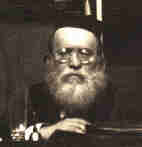 |
Hadrash Ve-Haiyunby the Reisha Rav, HaGoan Rav Aaron LevineElucidated and Adapted by Efraim Levine |
 |
Hadrash Ve-Haiyunby the Reisha Rav, HaGoan Rav Aaron LevineElucidated and Adapted by Efraim Levine |
Bo
Dedicated in honor of my father, the Grandson and Name Holder of the Reisha Rav
Rabbi Dr. Aaron Levine
In honor of the publication of his latest book
Case Studies in Jewish Business Ethics
Ktav Publishing
To Dedicate Please Contact Hadrash Ve-Haiyun
It shall be for you a sign on your hand and a remembrance
between your eyes.
(Shemos 13:9)
The mitzvah of tefillin is divided into two parts, the head and arm. We also know that the mitzvos of the Torah are divided into two parts, the mitzvos between man and his fellow man and the mitzvos between man and Hashem. Let us suggest that the head tefillin corresponds the mitzvos between man and Hashem and the arm tefillin to the mitzvos between man and his fellow man. With this comparison we can derive a few lessons with regard to the two types of mitzvos.
The arm tefillin is placed on the arm, which represents the actions of man. This teaches us that with regard to mitzvos between man and his fellow man, actions are what count, not good intent. One must be practical with friends and practicability is measured in terms of real benefit provided, not goodwill. On the other hand the head tefillin is placed on the head which represents man's thoughts and will. This teaches that with regard to mitzvos between man and Hashem, good intent is what counts. Hashem does not need our actions, but He does desire our good feelings and will.
A second lesson may be derived form the observation that the donning of the arm tefillin precedes the head tefillin. In addition, when removing the tefillin, first we remove the head tefillin and only then the arm tefillin. The head tefillin may never be worn without the arm tefillin in position. This teaches us that the mitzvos between man and his fellow take precedence over the mitzvos between man and Hashem. A person should never elevate his level of service to Hashem unless he first elevates his performance in the mitzvos between man and man. It is said, that before adopting a chumra between man and Hashem e.g., kashrus, a person should better adopt a chumra from the category of mitzvos between man and his fellow man e.g., lashon hara. Likewise, we find that the first Beis Hamikdash was destroyed as a result of sins from the category of man and Hashem. However, the exile was relatively short only seventy years. The second Beis Hamikdash on the other hand was destroyed because of unfounded hatred, a sin between man and his friend, and for this we are still in exile today.
Using this idea we can reinterpret a well known statement of chazal. In the aftermath of sin of the golden calf, we find that Moshe asked Hashem to reveal Himself. The mefarshim interpret this as Moshe seeking understanding of Hashem. Hashem responded by saying that he would remove his hand and make his back visible. The Gemara interprets this to mean that Hashem told Moshe that he would show him the kesher shel tefillin i.e., the knot of the tefillin, that lies in the back of the head. The mefarshim go on to explain that this means Hashem showed Moshe the daled of the head tefillin. There is a slight problem since it emerges that Hashem only showed the knot of the head tefillin. If so, the word for tefillin should be in the singular i.e., tefilla, not the plural i.e., tefillin. Chazal also teach us (Chulin 9a) that a talmud chacham must know how to tie the knot of the tefillin. This is simply interpreted as meaning that a talmud chacham must know practical halacha, even to the extent of knowing how to make the daled of the tefillin.
In addition to the simple interpretations, let us now suggest a homiletic one. Hashem showed Moshe that the way to understand Hashem is to tie the message of both tefillin's together. Only when a human being integrates the mitzvos between man and man with the mitzvos between man and Hashem will he be worthy of understanding Hashem. Likewise it is not enough for a talmud chacham to master both types of mitzvos independently. He must also integrate them into one entity. Every action must be weighed in terms of his relationship with Hashem and its affect upon others. We may further note that this knot of tefillin is compared to the back of Hashem. The Hebrew word used for back is ach'or'ay. This word is also translated as 'later.' The message Hashem told Moshe is that integration only comes 'later.' It is a skill that takes a lifetime to develop. It will only come with much work and effort.